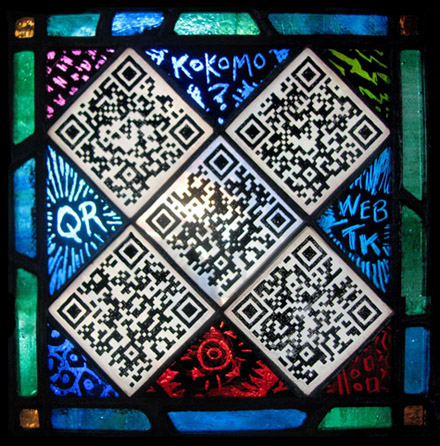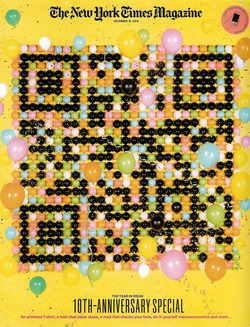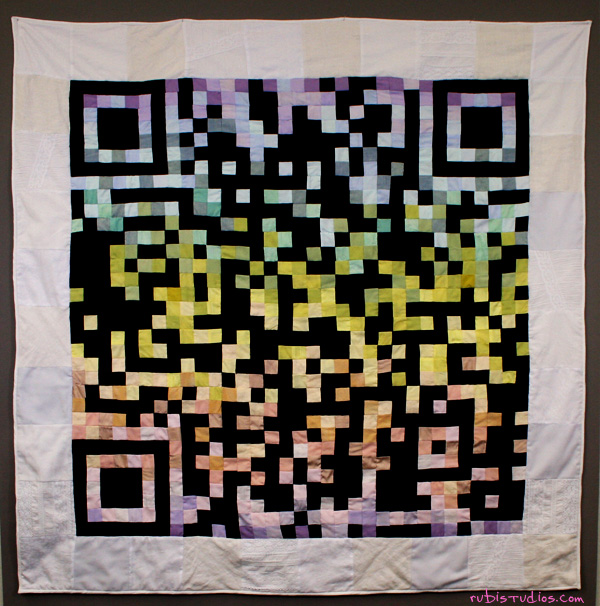October 11, 2011
QRazy Glass, part 1
I finished this panel last July, making it to show friends at the AGG conference in Asheville. It's my first, and so far only, attempt at incorporating QR (quick response) 2D barcodes into a stained glass panel.

Below the fold, in part 1, I'll do a brief intro to the QR code and have links to a variety of projects using QR codes - in art, illustration, and public monuments, and in uniquely creative public signage.
In the next few days I'll post part 2, where I go over how I made the prototype panel, and how to make your own QR code and some of the unique issues raised by trying to incorporate it into stained glass.
What is a QR code?
Basically, it's an image that can be read by a smartphone that will instantly call up text, link directly to websites, get contact information placed straight into your phone, upload images, go to map locations, and more. For more detailed info on its history and background - QRcode wikipage). More interesting to me than the technical details is how might these interactive codes be used in art, illustration and architecture? Is it worth the extra effort? Could it be more than a passing fad? My own interest was sparked in a similar way to this comics artist who found out about the QR code by visiting City Museum in St. Louis - How to Get a Quick Response from your Comic Book Customers
How can I read a QR code?
QR codes are mostly read with a smartphone or tablet with a camera. There are many readers available for free download, in all types of smartphones. Go to your app store and search for "QR reader" and many free apps will show up. I have 6 different QR readers on my phone, all for free. Red Laser, Qrafter and 2DSense seem to work the best on my iPhone. I've heard Zxing is best for Android phones, since Zxing comes from Google itself.
You can also decode a QRcode by submitting an image of it to this Zxing Decoder. It will give you the underlying text or link.
QR Code Projects in the News
These are some of the more interesting projects I've heard about that incorporate QR codes. I'll add more as I hear of more.
Arbor Day Event with QR codes, Central Park New York, 2010
World Park Campaign, Central Park, NYC, Arbor Day 2010
Tattoo Artist and Animation Mashup Using QR Code
Tattoo Artist tattoos QR code linked to Animation
Balloon QR code Illustration for Magazine Cover
NY Times Magazine cover, December 2010
click to enlarge image, scan to go to New York Times "year of ideas" website.

The most amazing thing to me about this is how well the code can scan when it is so roughly formed, with balloons no less!
QR Code Quilt
QR Code Quilt by Rubi McGrory out of Savannah, Georgia

The encoded text message is nice, but hardly seems worth the effort of encoding it in a QR code in the first place.
QR Code links to Memorial Website on Tombstone
This creeps people out a bit. Understandable, it's a cemetary. Still, I could see a similar idea coming into use in memorial stained glass windows.
QR Code on Tombstone Creates Dynamic Memorial. The QR code links to a memorial website.
(via Mashable)
QR Codes in Ceramic Tilework
The nature of the QR code would seem to lend itself especially to the medium of ceramic tiles. Here are 2 examples -
A QR Code Link with the Past, with a QR code done in ceramic tile as part of a larger figural sculpture.
Talking about iBarga is a tourist campaign for a medieval town in Italy. The city itself has QR codes throughout explaining the different sites to see, with audio guides and website information linked to the QR codes. The QR codes are fired into ceramic tiles and installed permanently. A video about the project.
In the next few days I’ll post more specifically about my stained glass QR project and how QRcodes might be incorporated in future stained glass projects.
In the meantime, one more thought to ponder...
Is there already a QR backlash?
There are naysayers, especially in the world of advertising/marketing, as in this article - Death to the QR Code. The reality is that this might be a fad and the technology could disappear in the next decade, or the next 2 years. Or it could hang on. Everything tends to cycle very quickly in computer and internet technology, often gauged in months rather than years. Did you know that QR codes are not a new thing but are making a comeback (just one example - QR codes making a comeback with Wikipedia?).
What will happen once the novelty wears off? How long will it take for the technology to be totally supplanted by something else? Will there be any way to read these in 10 years? 20? 50?
How much does it matter?
Posted by Tom at October 11, 2011 11:59 AM